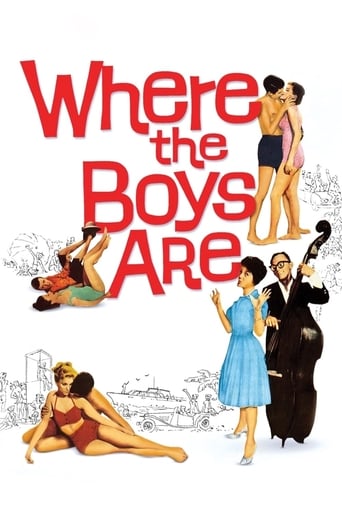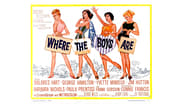Antonius Block
This movie is first and foremost a somewhat dippy teen film that you might enjoy for the antics of Spring Break 50+ years ago (and oh how times have changed!). The movie seems surprisingly daring in the beginning when a young woman references the Kinsey report and alludes to premarital sex being natural, but eventually you'll realize the movie is conservative, still more in the 50's than it is in the 60's. It's watered down and feels sanitized, and it was tough to see the college women on Spring Break ridiculously desperate for men, actually believing they're going to find guys who will propose to them on the trip (huh??), and one simply wanting to become a 'baby factory'. In the end, its main theme is the age old clash between men who want sex, and women who want commitment. I suppose that's to be expected from a movie called "Where The Boys Are", and reflective of the times. The most poignant and serious moments come from the character played by Yvette Mimieux, who has been having sex with a guy, thinking he loves her. When she arranges to meet him in a motel, she finds he's sent one of his friends instead, after telling her she's easy – and gets raped. By my count, she tells him "no" 9 times as he advances, all smiles, about to force himself on her. None of it is shown, we just see her despondently walking into traffic, a scene which is ridiculously overplayed. Unfortunately (and outrageously) the moral has nothing to do with the guys who took advantage of her and devastated her – neither of them are seen again, presumably happily traveling north having "gotten some" – it's her ruing meeting a guy in the future who'll find out she's no longer a virgin because of her Spring Break escapades. Sigh, and grrr. And, with the Code being in effect, where evil was not allowed to win – it's clear, that this was not considered rape and not considered evil. What a horrible, horrible message buried within this silly movie. And how opposite it is to the initial premise that women should not have to "wait until marriage". If you can watch it just for the goofiness – like guys picking up and moving a car, and characters jumping in to a giant tank of water in a nightclub and making silly faces – you will probably enjoy it. You have a poor man's Marilyn Monroe (Barbara Nichols), poor man's jazz (Frank Gorshin of Riddler fame, sporting Coke bottle glasses), and a dapper George Hamilton in a black polo shirt on the beach. You have very well dressed guys and girls on the beach and on dates. You have Connie Frances making her debut and singing. I have to say, it held my interest, but I can't help but feel it could have been so much better if it had been more serious in one of its directions instead of lukewarm in all, and been a little more ahead of its time. It's certainly retrograde by today's standards.
capone666
Where the Boys Are Considering the annual antics of spring break, there's a good reason why the state of Florida is shaped like a penis.Thusly, female college students, like the ones in this drama, flock to Fort Lauderdale every year.Students from an uptight Midwest university (Connie Francis, Dolores Hart, Yvette Mimieux, Paula Prentiss) head down south on their spring break in hopes of engaging in the premarital sex that their school forbids.When they arrive, the girls quickly pair off with their male counterparts (George Hamilton, Frank Gorshin, Jim Hutton, Rory Harrity) and harmless heartbreaks ensue.While the experienced girls discover they have more to learn about sex, the inexperienced ones are broken by the darker side of the holiday.Not only does it depict the sun-seeking pilgrimage bluntly but Where the Boys Are also boasts a memorable soundtrack.Now if only Ft. Lauderdale could find the economic benefit to used condoms Green Light vidiotreviews.blogspot.com
blanche-2
Delores Hart, Yvettte Mimeux, Paula Prentiss, and Connie Francis are "Where the Boys Are," a 1960 film about spring break in Fort Lauderdale. The boys are Jim Hutton, George Hamilton, and Frank Gorshin.The four young women drive down to Fort Lauderdale for spring break, with an agenda of having fun and meeting men. The exception to this is Merritt (Hart) who has some school work to catch up on. The first reel is the last we hear of school work. With the exception of Angie (Connie Francis), the gals meet guys immediately - Tuggle (Prentiss) meets TV (Hutton), who hitches a ride to Lauderdale with them; Merritt meets the wealthy Ryder (George Hamilton), and frail, pretty Melanie (Mimieux) meets Dill (John Brennan). Angie later meets a jazz musician (Gorshin).The questions are, can true love be found during spring break? And, how far do you have to go to hook a man? Despite Merritt's free-thinking, she and Tuggle intend to stay pure; Angie doesn't have a choice; and Merritt -- Merritt is in for some tough realizations.All in all, a fun movie and a great look at the '50s mores and the power of the Hays code, which was still punishing girls who had sex before marriage.The best things about Where the Boys Are is seeing all these stars as young and fresh, with their movie careers just beginning, and another chance to hear Connie Francis sing the title song and "Turn on the Sunshine." She was terrific. Barbara Nichols plays a sexy performer and does "Have you Met Miss Fandango?" With the exception of Delores Hart, who became a nun, all of these youngsters would go on to successful careers. The young man who played Dill, John Brennan, was blackballed after yelling at a director who was demeaning the singer Odetta; he went on to work behind the scenes and killed himself in 2007 after his wife's death. Already a huge singing star by 1960, Francis, of course, is still singing after a miserable life that includes the death of her brother, rape, and a bipolar disorder.Spring breaks today still have plenty of booze and suntans but also plenty of everything else (including young women disappearing) - enjoy this film about a much more innocent time.
DKosty123
I kind of put this film in the middle of old age. The cast is priceless now as I fell in love with Paula Prentiss long ago even though in this film she is presented in her comedienne persona. I think she could have been better utilized but Hollywood was uncomfortable with tall actress's when this one was made. The late Jim Hutton plays the same person he always plays in films. Like seeing excellent character actors like Chill Wills in any film. Connie Francis sold most of her records based on her fame in this film.Actually by 1960, the sexual values represented in this film were 1950's values. In fact, what this film was trying to do was take an attractive cast to try & keep women in their traditional role here of looking for a man as the only way to be happy. Considering that divorce rates were already climbing by 1960 creating many single parent house holds, it was going to take Hollywood several more years before they would even get to this stark reality.There is some priceless comedy in this film as Frank Gorshin who is a stand up comedian & then the Riddler on Batman, is at his rubber faced best here. People now forget Gorshin was a top impressionist during this era. Some of his talent shows here. This Technicolor film is fine for the scenery & cast but put your brain away as the plot is very light weight.







